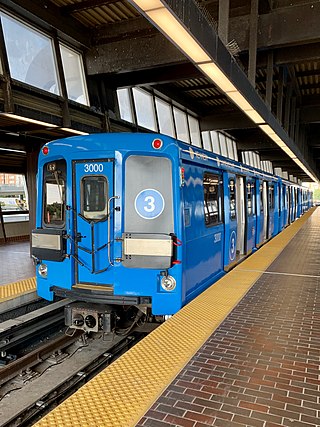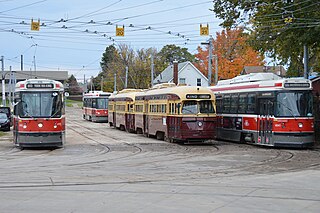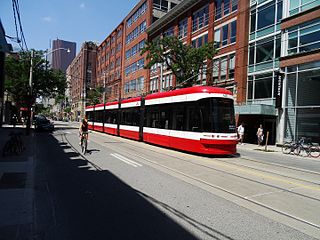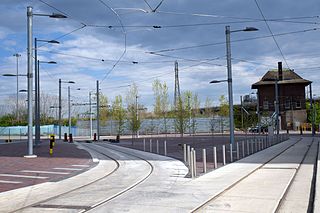
The Toronto Transit Commission (TTC) is the public transport agency that operates bus, subway, streetcar, and paratransit services in Toronto, Ontario, Canada, some of which run into the Peel Region and York Region. It is the oldest and largest of the urban transit service providers in the Greater Toronto Area, with numerous connections to systems serving its surrounding municipalities.

Line 3 Scarborough, originally known as Scarborough RT (SRT), was a light rapid transit line that was part of the Toronto subway system in Toronto, Ontario, Canada. The line ran entirely within the eastern district of Scarborough, encompassing six stations and 6.4 kilometres (4.0 mi) of mostly elevated track. It connected with Line 2 Bloor–Danforth at its southwestern terminus, Kennedy, and terminated in the northeast at McCowan. Until its closure in July 2023, the system had a ridership of 3,908,000.

The Toronto subway is a rapid transit system serving Toronto and the neighbouring city of Vaughan in Ontario, Canada, operated by the Toronto Transit Commission (TTC). As of September 2023, the subway system is a rail network consisting of three heavy-capacity rail lines operating predominantly underground. As of December 2022, three new lines are under construction: two light rail lines and one subway line.

Line 2 Bloor–Danforth is a subway line in the Toronto subway system, operated by the Toronto Transit Commission (TTC). It has 31 stations and is 26.2 kilometres (16.3 mi) in length. It opened on February 26, 1966, and extensions at both ends were completed in 1968 and again in 1980.

The Toronto streetcar system is a network of eleven streetcar routes in Toronto, Ontario, Canada, operated by the Toronto Transit Commission (TTC). It is the third busiest light-rail system in North America. The network is concentrated primarily in Downtown Toronto and in proximity to the city's waterfront. Much of the streetcar route network dates from the 19th century. Three streetcar routes operate in their own right-of-way, one in a partial right-of-way, and six operate on street trackage shared with vehicular traffic with streetcars stopping on demand at frequent stops like buses. Since 2019, the network has used low-floor streetcars, making it fully accessible.
The Relief Line was a proposed rapid transit line for the Toronto subway system, intended to provide capacity relief to the Yonge segment of Line 1 and Bloor–Yonge station and extend subway service coverage in the city's east end. Several plans for an east–west downtown subway line date back to the early 20th century, most of which ran along Queen Street.
Accessibility for people with disabilities on the Toronto Transit Commission (TTC) system is incomplete but improving. Most of the Toronto subway system was built before wheelchair access was a requirement under the Ontarians with Disabilities Act (ODA). However, all subway stations built since 1996 are equipped with elevators, and elevators have been installed in 44 stations built before 1996. Over 75 percent of Toronto's subway stations are accessible. The original plan was to make all stations accessible by 2025; however, a few stations might not be accessible until 2026.

Transit City was a plan for developing public transport in Toronto, Ontario, Canada. It was first proposed and announced on 16 March 2007 by Toronto mayor David Miller and Toronto Transit Commission (TTC) chair Adam Giambrone. The plan called for the construction of seven new light rail lines along the streets of seven priority transit corridors, which would have eventually been integrated with existing rapid transit, streetcar, and bus routes. Other transit improvements outlined in the plan included upgrading and extending the Scarborough RT line, implementing new bus rapid transit lines, and improving frequency and timing of 21 key bus routes. The plan integrated public transportation objectives outlined in the City of Toronto Official Plan, the TTC Ridership Growth Strategy and Miller's 2006 election platform.

Line 5 Eglinton is a light rail line that is under construction in Toronto, Ontario, Canada. Owned by Metrolinx and operated by the Toronto Transit Commission (TTC), the line will be part of the Toronto subway system as its fifth route. The line is being constructed in two phases, with two extensions approved by the Toronto government but not yet under construction.
The Sheppard East LRT was a proposed light rail line in Toronto, Ontario, Canada. It was first announced as part of the Transit City proposal in 2007. The Sheppard East LRT as proposed was to be 13 kilometres (8.1 mi) long, travel along Sheppard Avenue from Don Mills subway station to east of Morningside Avenue, and be operated by the Toronto Transit Commission (TTC).
The Eglinton East LRT (EELRT), also known as Line 7 Eglinton East and formerly known as the Scarborough Malvern LRT, is a proposed light rail line in Toronto, Ontario, Canada. The line would be entirely within the district of Scarborough. It was originally part of Transit City, a 2007 plan to develop new light rail lines along several priority transit corridors in the city.
The Jane LRT is an inactive proposal for a light rail line in Toronto, Ontario, Canada. It was originally proposed in 2007, cancelled in 2010, and later revived in the 2013 "Feeling Congested?" report by the City of Toronto, where it was labelled as a "Future Transit Project". However, in April 2019, Ontario Premier Doug Ford announced the province's plans for rapid transit development and funding for the Greater Toronto Area that omitted the Jane LRT.

The Toronto Rocket (TR) is the fifth and latest series of rolling stock used in the Toronto subway system in Toronto, Ontario, Canada. Owned and operated by the Toronto Transit Commission (TTC), the trains were built by Bombardier Transportation in Thunder Bay, Ontario, to replace the last remaining H-series trains, as well as increase capacity for the Spadina subway extension to Vaughan that opened in 2017. They operate in a six-car configuration on Line 1 Yonge–University and a four-car configuration on Line 4 Sheppard. The sets are stored and maintained at the Wilson and Davisville Yards. The first six-car TR train entered passenger service on Line 1 in July 2011, and four-car TR trainsets entered service on Line 4 in May 2016.

The Flexity Outlook is the latest model of streetcar in the rolling stock of the Toronto streetcar system owned by the Toronto Transit Commission (TTC). Based on the Bombardier Flexity, they were first ordered in 2009 and were built by Bombardier Transportation in Thunder Bay and Kingston, Ontario, with specific modifications for Toronto, such as unidirectional operation and the ability to operate on the unique broad Toronto gauge.
Network 2011 was a plan for transit expansion created in 1985 by the Toronto Transit Commission. It was centred on three proposed subway lines: the Downtown Relief Line, Eglinton West Line, and the Sheppard Line. Only a portion of the Sheppard Line was built. The Eglinton West and Downtown Relief Lines were cancelled; they were superseded by the Eglinton Crosstown light rail line and the Ontario Line respectively.

In 1921, the Toronto Transportation Commission (TTC) was created to integrate and operate the Toronto streetcar system. It inherited the infrastructure of two separate streetcar operators: the Toronto Railway Company (TRC) and Toronto Civic Railways (TCR). The TTC immediately embarked on a program to connect the TRC and TCR lines into one network. The TTC had to rebuild most of the track to provide a wider devilstrip so that the wider Peter Witt streetcars it was ordering could pass without sideswiping. Between 1938 and 1945, it placed five orders for air-electric PCC streetcars to replace the old, wooden streetcars of the TRC, and to address rising ridership. Between 1947 and 1951, the TTC placed three orders for all-electric PCC cars, with one order equipped with couplers for multiple-unit operation. Between 1950 and 1957, the TTC purchased PCCs from four American cities. By 1957, the TTC had more PCCs than any other city in North America. After the opening of the Bloor–Danforth subway in 1966, the TTC considered terminating all streetcar service in Toronto. However, in 1972, a citizens group led by Jane Jacobs and Steve Munro called "Streetcars for Toronto" persuaded the City to retain streetcar operation. This led to the development of the Canadian Light Rail Vehicle (CLRV) and its longer, articulated cousin, the Articulated Light Rail Vehicle (ALRV), to replace the aging PCC fleet. The Accessibility for Ontarians with Disabilities Act, 2005 (AODA) mandated that the next generation of streetcars be wheelchair-accessible. Thus, to replace the CLRVs and ALRVs, Bombardier adapted its low-floor Flexity Outlook model for the TTC to navigate the Toronto streetcar system's tight curves and single-point switches, characteristics set in 1921 to accommodate Peter Witt streetcars, as well as for the unique broad gauge.
SmartTrack is a municipal proposal to enhance GO Transit rail service within Toronto, Ontario, Canada. It takes advantage of the province's existing GO Transit Regional Express Rail plans. SmartTrack has evolved since it was originally proposed by Toronto mayor John Tory as the centrepiece of his 2014 mayoral election campaign.
The Big Move is a regional transportation plan (RTP) published in 2008 and consisting of 62 rapid transit projects to be implemented across the Greater Toronto and Hamilton Area (GTHA). These rapid transit projects are intended to form a seamlessly integrated regional rapid transit network, which is the first priority action in the regional transportation plan. These projects form two long-term templates with 15 and 25 year horizons. These templates outline broad projects; specific details about technology, alignment, stations and service levels for each project are subsequently determined though a cost–benefit analysis or an environmental assessment process.

The 514 Cherry was a streetcar route of the Toronto streetcar system in Toronto, Ontario, Canada, that operated from June 19, 2016, until October 7, 2018. The 514 operated through the financial district and downtown Toronto between Dufferin Gate Loop and the Distillery Loop. It used to supplement with the 504 King service along King Street, specifically to the dense residential areas in Liberty Village, the Canary District and the Distillery District. The City of Toronto's "King Street Visioning Study" proposed a transit and pedestrian corridor through which this route would operate.

Distillery Loop is a streetcar loop in the Toronto streetcar system in Toronto, Ontario, Canada that lies at the south end of the Cherry Street branch – originally dubbed the Cherry Street streetcar line – that runs from a streetcar junction on King Street East south along Sumach and Cherry Streets. The loop opened in June 2016 and is some of the newer streetcar infrastructure in the city. The Cherry Street branch is currently served by the 504A King streetcar route which has its eastern terminus at Distillery Loop.












